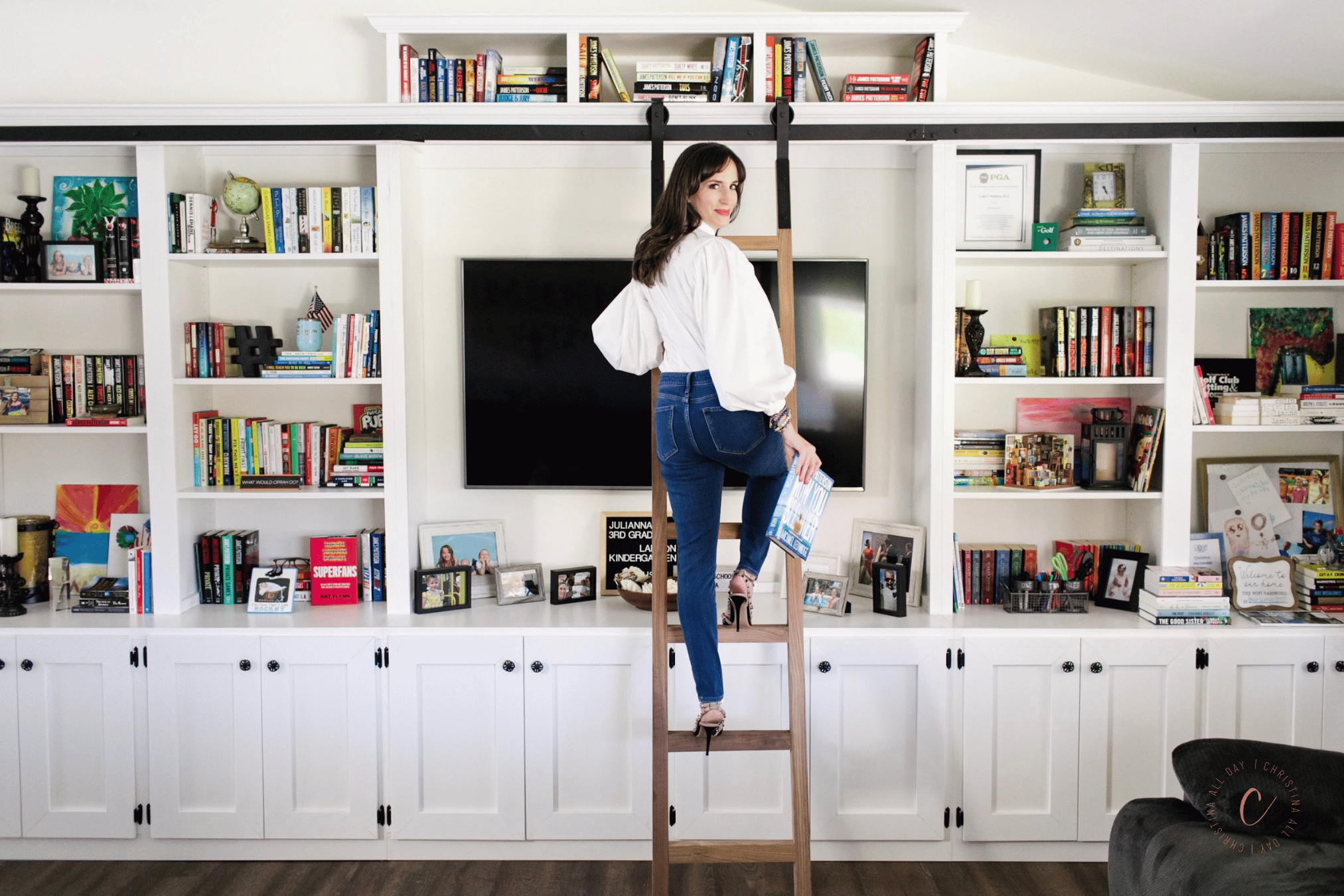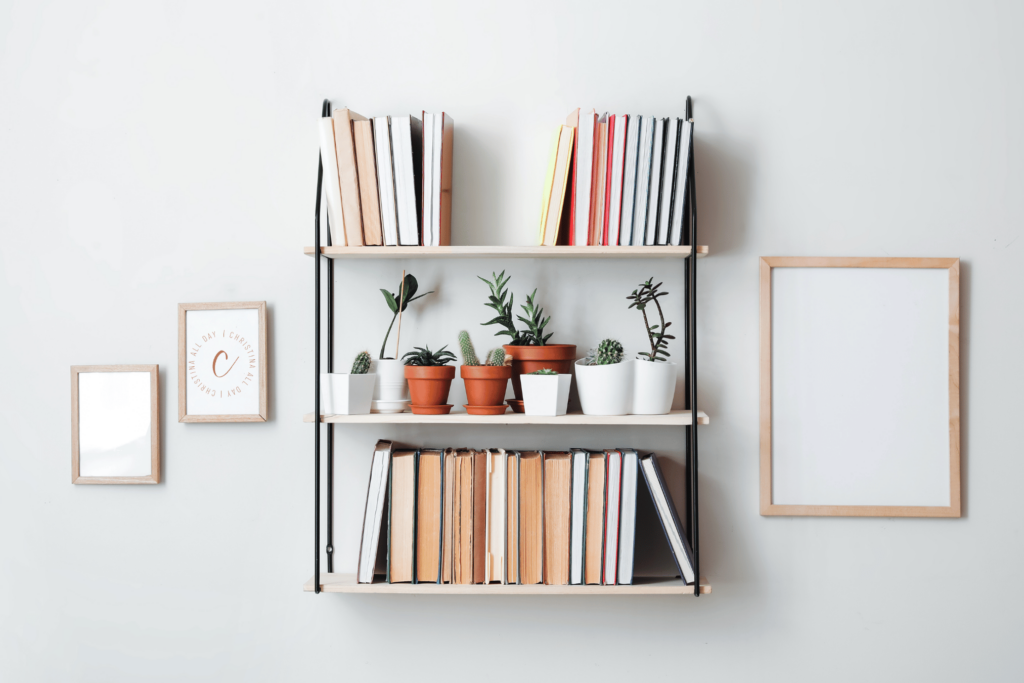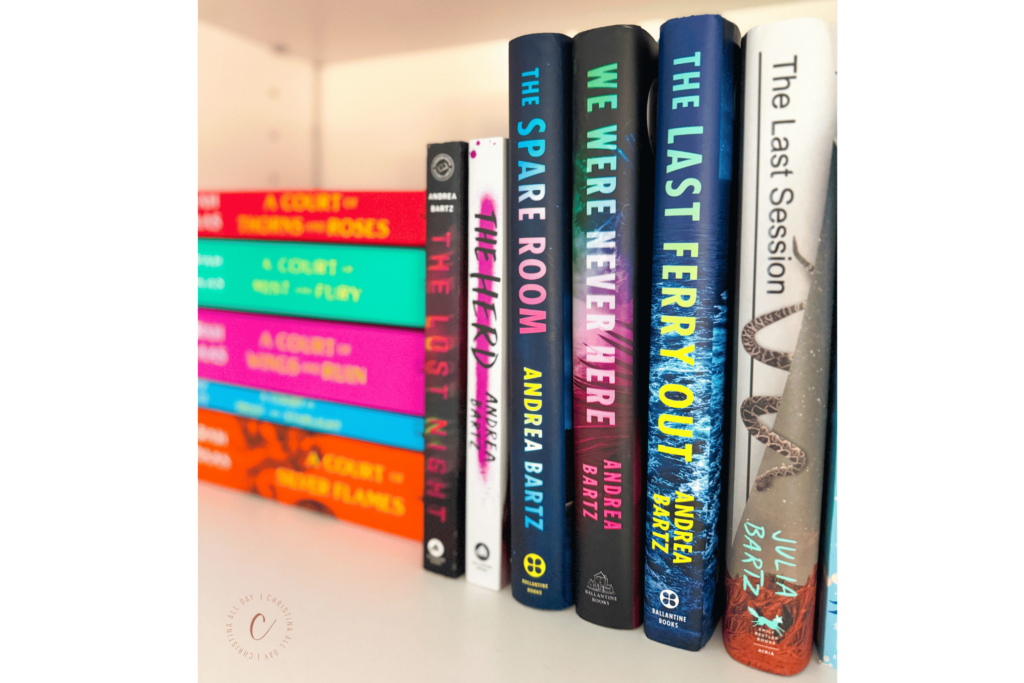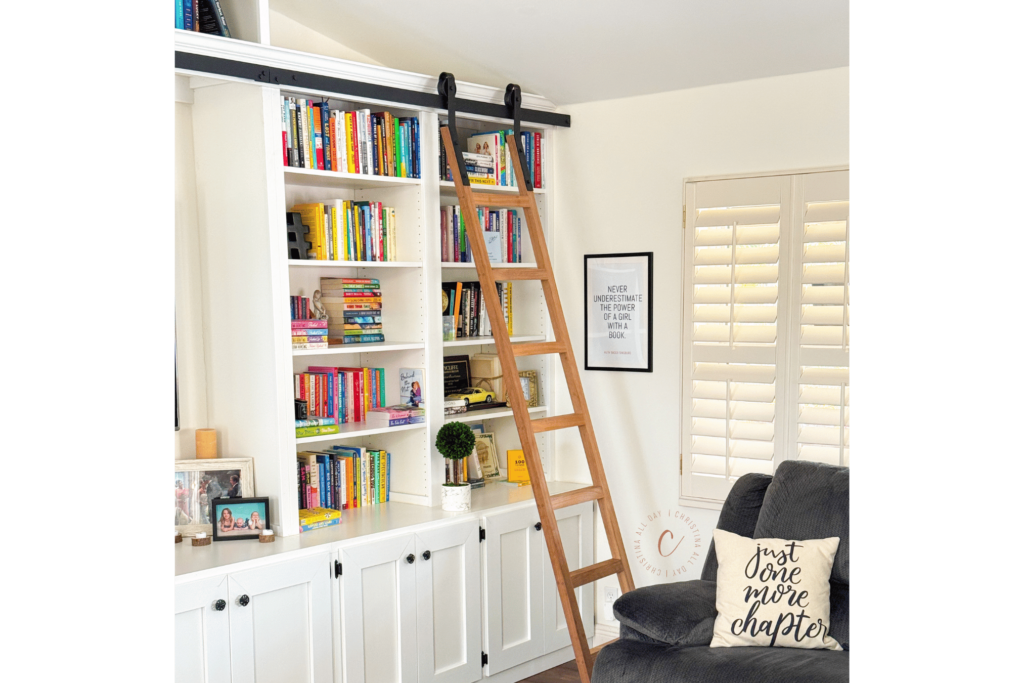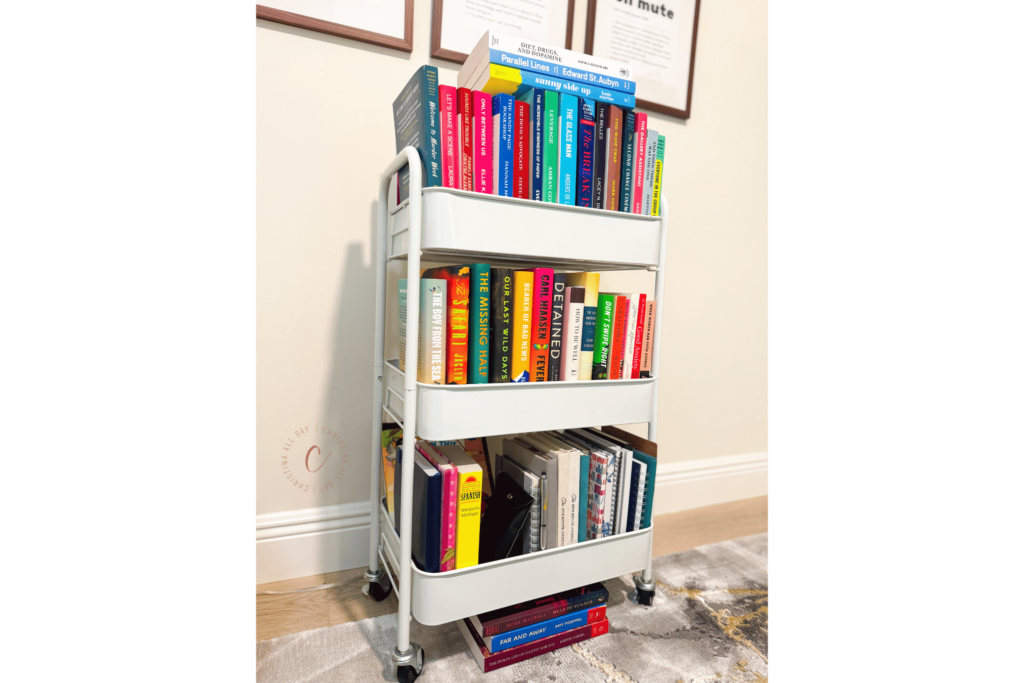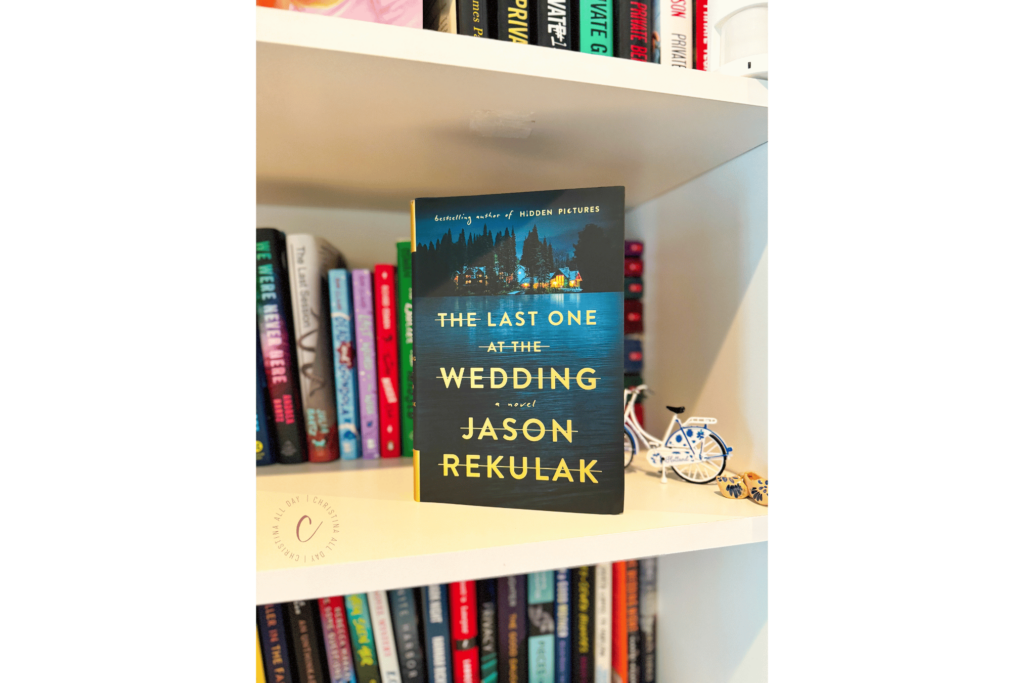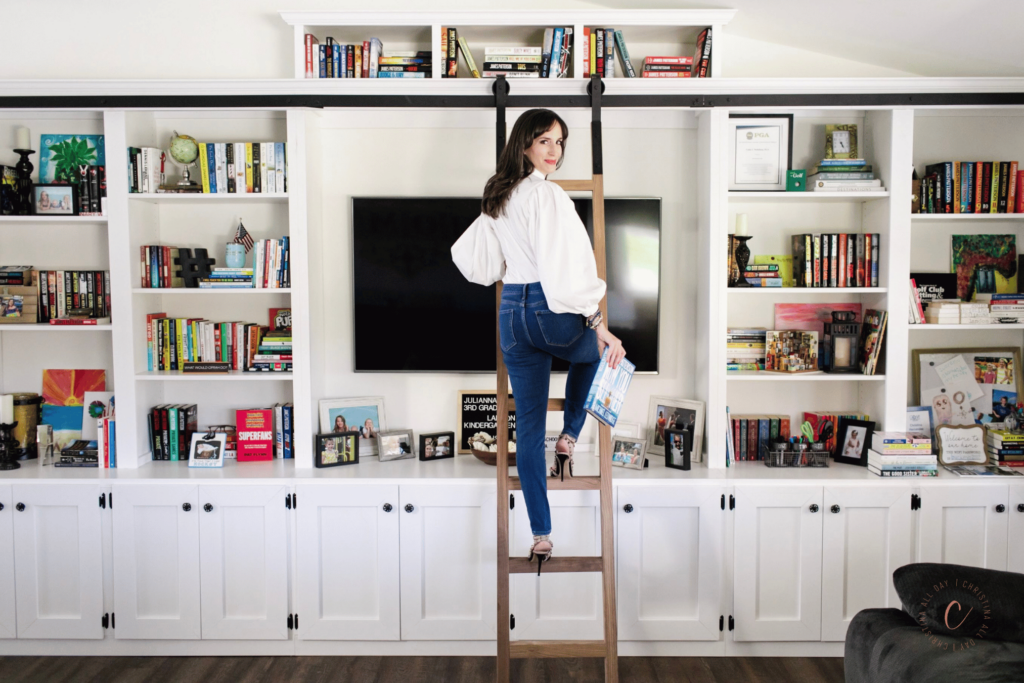No, you don’t need a Dewey Decimal System in your living room, but you do need a plan. Organizing your books isn’t just about tidiness or making your shelves look cute for Instagram (though, let’s not lie, that’s definitely a Bookstagram perk I love).
A well-organized bookshelf can actually make your whole reading experience smoother, more joyful, and way less stressful.
Imagine this: you’re in the mood for a cozy mystery novel, and instead of digging through random stacks or an entire shelf, boom—you know exactly where to find it. No more “Where did I put that book again?” moments. Just pure bookish bliss.
A good system not only helps you keep track of what you’ve read (and what you still want to read), but it also turns your bookshelf into a little museum of your reading life. Kinda cool, right?
My personal preference is to have non-fiction books and reference books together and in alphabetical order by the author’s last name, but split up between books I’ve read and ones that are on my TBR.
Mystery novels, romances, general fiction, and other chapter books get organized by genre first, then by alphabetical order by the author’s last name, unless they’re part of a series. Then, they go in order of publication date. These are also split up between read and TBR.
The bottom shelf in my family room is reserved for my kids’ board books in all the aesthetic ways… a rainbow, of course! (More on that later for my Home Edit stans.)
The Big Benefits of Getting Your Books in Order
1. Say Goodbye to Shelf-Stress
Messy bookshelves can make choosing your next read feel like a chore. But when your collection is sorted in a way that makes sense to you, it’s actually relaxing. Like, walk into the room, see everything neatly in its place, take a deep breath, kind of relaxing.
2. Rediscover Old Favorites
You know those books you bought years ago and totally forgot about? With a little organization, you’ll start stumbling across long-lost gems that’ll make you go, “Oh yeah! I’ve been meaning to read this!” It’s like shopping your own shelf.
3. Your Books, Your Story
How you organize your favorite books says a lot about you. Sort by genre? You’re into variety. By mood or theme? You like a little emotional curation. Publication date? Color? However you do it, your shelf becomes a reflection of your reading personality.
4. Make the Most of Your Space
Whether you’ve got built-ins or just a few shelves in the corner, a smart organization method can help you make every inch count. Vertical stacking, creative displays, or even rainbow-color-coding for kids’ books or picture books—whatever works for your space and style.
5. Put Your Personality Into It
There are no rules. Mix it up however you like. Love organizing by author’s first name or the color of the spine? Go for it. It’s your bookshelf, after all.
Let’s Bust Some Bookish Myths
Myth: You have to use the Dewey Decimal System.
Nope. Unless you’re secretly running a library out of your living room, Dewey is totally outdated. (My kids don’t even know what this is.)
Myth: Only non-fiction needs organizing.
Fiction deserves just as much love! Don’t let your novels feel left out.
Myth: You need a huge collection to bother organizing.
Even a shelf or two can benefit from a little structure. Size doesn’t matter. The organization does.
Smart (and Fun) Hacks for Book Organization
Mix and Match Your System
Why pick just one method? Combine genres, color coding, or even “vibe-based” categories like “Cozy Sunday Reads” or “Books That Made Me Cry.” (Insert Broken Country here under books that made me cry.)
Think Vertical
When in doubt, go up. Tall shelves save space and look super polished.
Declutter Often
Be honest: Are you really going to reread that book you didn’t love? Let it go, and make room for new favorites. Donate, swap, gift, or sell on PangoBooks!
Add a Techy Twist
Try cataloging apps or even QR codes that link to summaries and reviews. It’s like giving your shelf a digital upgrade.
Make It Pop
Use fun bookmarks, labels, bookish stickers, or even tiny section signs to make things easier (and cuter).
Host a Book Swap
Trade stories and stories—gather some friends, exchange books, and maybe even discover a new favorite author.
A Few Mistakes to Avoid (So You Don’t Have to Learn the Hard Way)
- Don’t ignore your personal preferences. If someone else’s method doesn’t feel right for you, ditch it. Your bookshelf, your rules.
- Keep it simple. If your system requires a decoder ring, it’s probably too complicated.
- Stay on top of it. Like any good thing, your shelves need a little upkeep from time to time.
- Know your space. Don’t try to cram too much in, and don’t let half-empty shelves look sad either.
- Make it functional. Pretty is great, but if you can’t find anything, what’s the point? (This is why I don’t do the wrong way shelving trend.)
Be open to change. Your taste will shift over time. Let your shelves grow with you. - Track your collection. Whether it’s a spreadsheet, an app, or sticky notes, know what you have so you’re not buying duplicates (been there!).
Finding a Book Organization Style That Works for You
There’s no one-size-fits-all when it comes to organizing your books, and honestly, that’s the fun of it. The way you set up your shelves should match how you read, how you live, and what makes you feel at home in your space.
Whether you’re aiming for that dreamy, color-coded look or just want to be able to find your favorite fantasy novel without tearing the place apart, the right system can totally change how you experience your library.
The key? Finding something that feels good to use. It should make your collection easier to navigate and maybe even inspire you to pick up a book more often.
What Actually Matters When You’re Getting Started
Know Your Why
Before you start moving books around, think about why you want to organize in the first place. Is it to make things look better? To keep track of what you’ve read? To avoid accidentally buying the same book twice? Knowing your reason makes it way easier to build a system you’ll actually stick with.
There’s No “Right” Way
Seriously. You can sort alphabetically, by color, by genre, by mood, by “books with my new fictional boyfriends”—whatever floats your boat. You don’t have to follow someone else’s rules. Try different methods until something clicks.
Don’t Be Afraid to Mix Things Up
Sometimes the best system is one that combines a few different styles. Maybe you group fiction by genre, but organize non-fiction by topic. Or you keep your TBR (to-be-read) pile separate from your favorites. Play around with it. You might stumble on something unexpectedly perfect.
Think About Visitors (If You Get Them)
If you love when guests browse your shelves, maybe go with a setup that encourages conversation, like sorting by theme or mood. It’s a great way to break the ice and share recommendations.
Make It Fit Your Life
If you lend books out a lot, a super-precise system might drive you nuts when something goes missing. If you’re constantly rearranging furniture, maybe don’t put your favorite reads in hard-to-reach spots. Let your organization flow with your actual day-to-day habits.
Smart, Low-Key Ways to Level Up Your Shelf Game
- Make it a habit. Tidy one top shelf while you wait for your coffee to brew. Little by little goes a long way.
- Use an app. There are some great tools out there to help you keep track of what you own (and what you’ve lent out).
- Get creative with themes. Organize a section around “comfort reads” or “travel inspo.” It makes browsing way more fun.
- Do a monthly check-in. Pick a day to glance over your shelves and make quick tweaks. It helps keep everything in shape without feeling like a project.
- Swap ideas with fellow readers. Talking to friends about their shelves might give you new ideas and maybe a book recommendation or two.
- Add some visual flair. Whether it’s art, a favorite quote, or a little plant, your bookshelf should reflect your vibe.
Challenge yourself. Set mini-goals around genres and use that to guide how you organize. It keeps things fresh.
A Few Things to Watch Out For
- Don’t feel like you have to explain your system to anyone. It’s your space.
- Avoid systems that make it harder to grab a book. Easy access should always win.
- Labels aren’t just for libraries. A few clear markers can save you a lot of time.
- Don’t shoot for perfect from the start. Tweak and adjust as you go.
- Make sure your setup is cozy. You should want to sit and read when you’re near your shelves.
- Change it up now and then. Let your shelves grow with you.
- Keep a list somewhere (even if it’s a notebook or app) of what you have. It helps more than you’d think.
Let’s Talk Categories: Genres, Authors, and All the Fun Stuff
Categories are where the magic really starts to happen. Once you have some sort of system—whether it’s by genre, author, theme, or even just mood—you’ll find it so much easier to grab the right book when the reading itch hits.
Go by Genre
This one’s a classic for a reason. Fiction, non-fiction, fantasy, romance, memoir, self-help—grouping by genre gives your collection an easy rhythm. If you’ve got a big stash of thrillers, you might even break it down further into spy stories vs. psychological suspense.
Author Love
Sorting by author is a great way to showcase the voices you love. It’s also a super helpful approach if you tend to binge-read an entire author’s backlist (guilty). Give your faves their own little corner of the shelf. (James Patterson, Abby Jimenez, Colleen Hoover, Liv Constantine… okay, I’ll stop now.)
Mix It Up
You don’t have to choose between genres or authors. You can totally create little blends—like “Women Writing Sci-Fi” or “Black Authors Across Genres.” These mini-collections can lead to new insights and reading adventures.
Mind the Gaps
Don’t cram every inch of shelf space. Leaving some breathing room makes your library feel more relaxed and easier to browse. Plus, it leaves space for new finds!
Debunking More Myths About Categorizing
- Strict categories aren’t required. Sometimes loose, flexible sections are the most fun to browse.
- Big collections aren’t a must. You can totally organize your shelf of 20 adult books. It’s still worth doing.
- You don’t need a degree in library science. Trust your gut. You know your books better than anyone.
A Few Fun Ideas to Keep Things Interesting
- Cross-categorize. Mix genres with time periods, like “Historical Mysteries” or “Modern Romance.”
- Create themed displays. Rotate them like you would a gallery wall.
- Get your friends involved. Let them suggest categories or rearrange a shelf for fun.
- Add little tags with notes—sequels, book pairings, or quick reviews.
- Leave open spots. Not every book needs a permanent home. Some deserve to float for now.
If you’re just starting out, the biggest takeaway is this: you’re not organizing your books for anyone else. Do what makes your shelves feel like your happy place. Everything else is just extra.
Make Your Bookshelves Look Amazing (Without Losing the Plot)
Organizing your books is great, sure, but adding a little visual magic? That’s where the fun really starts.
You don’t have to be an interior designer to pull off a good-looking shelf. With a few simple tricks, your shelves can be both functional and fabulous.
First up, color coordination. Yep, the rainbow effect is real, and it works. Lining your books up by color can completely transform your shelf. It’s about pretty vibes and can actually help guide your eyes to the right section based on how you’re feeling that day. This is also adorable for children’s books. (My kids love it!)
Try mixing up how you stack things, too. All vertical rows can start to feel a little stiff. A few horizontal stacks here and there? Instant depth and style. Bonus: They make great natural bookends.
And don’t be afraid to sprinkle in a few non-book items. Photos, little plants, a candle, or even a sculpture can add personality and create those little moments that make you stop and smile when you pass by.
Another simple trick? Vary the heights. Grouping books by size adds rhythm and keeps things from looking too blocky. And if you want to go full cozy-library mode, lighting makes a huge difference. A small lamp or some wall sconces can change the whole vibe, especially for those evening reading sessions.
Now, let’s clear up a few things people often get wrong.
No, having a beautiful shelf doesn’t mean you have to give up organization. You can totally have both. Also, your shelves don’t need to look like a catalog shoot 24/7. Real life is allowed here—including stacks of half-read books or the little knick-knack from your last trip that you can’t part with.
And no, you don’t need to drop a ton of cash. Thrifted treasures and DIY projects can be way more charming than anything mass-produced.
Want to give your display a little boost? Try slipping in a few picture frames (empty or filled—up to you), layer books with taller ones behind shorter ones for depth, or add some greenery to warm things up. Seasonal displays can also be a blast. Change things up for fall, winter, summer beach reads—whatever feels fun.
Just remember—don’t overdo it. Cramming every inch with stuff can start to feel chaotic. Leave a little breathing room. And whatever you do, don’t forget that the whole point is to actually use your shelves. Pretty is great, but functionality should never take a backseat.
Shelving That Actually Works for You (And Looks Good Too)
The kind of shelves you pick can totally change how your library feels. It’s not just about slapping up a few boards and calling it a day. The materials, layout, and even the furniture you use all play into how cozy, efficient, and your book nook feels.
Start with what your space needs. Wood brings warmth, metal adds a modern edge, and combining materials can strike a nice balance. Think about how it fits with the rest of your space so it doesn’t feel out of place.
Adjustable shelves are also super handy. Books come in all shapes and sizes, and your collection’s going to change over time. Being able to tweak shelf heights means your setup stays useful no matter what you add next.
And don’t sleep on corner units. They’re great for maximizing weird little spaces. Dress them up right, and they become a standout feature, not just a filler. This sits in the corner of my bedroom and I love it.
If nothing off-the-shelf fits quite right, think about going custom. Yes, it can be a little more of an investment, but if you’ve got a vision (and the space), it might be worth it. I have one wall that’s custom, and the other is the Ikea Billy Bookcase hack.
Also, you don’t have to stick with traditional shelving. Think outside the box—crates, vintage ladders, or old furniture pieces can be repurposed in really cool, different ways. These unexpected touches add character and can make your setup feel super personal. This is a library cart that sits in my office, which is just the cutest!
Here are a few shelf hacks to consider:
- Mix different styles to avoid that cookie-cutter look. A little contrast makes everything pop.
- Upcycle old furniture into shelving. It’s eco-friendly and one-of-a-kind.
- Use fun bookends that match your vibe—quirky, classic, whatever feels right.
- Add vertical dividers to keep genres or sections neat.
- Glass doors are great if you’ve got special editions you want to display (and protect).
Create little zones—like a “books from friends” shelf or a spot just for seasonal reads. - Personal mementos make great shelf accents. Travel souvenirs, photos, handwritten notes—they all tell your story.
Making Digital Library Management Work for You
Let’s be honest—keeping track of books can be a bit of a mess if you don’t have some kind of system. Between physical books, e-books, library loans, and wishlists, it’s easy for things to fall through the cracks. That’s where digital library management comes in.
Using digital tools doesn’t mean giving up the magic of physical books. It just adds another layer to help you stay organized, track your reads, and maybe even discover something new about your reading habits. Think of it like your reading life’s digital assistant—there to help, not take over.
Apps like Goodreads or Storygraph can be a game-changer. They let you catalog your books, leave reviews, keep track of your progress, and see what your friends are reading. It adds a bit of a social twist to your reading life, which can be surprisingly motivating.
Creating your own digital database can also be fun (and oddly satisfying). You can track everything from genres and page counts to how a book made you feel. Plus, seeing patterns in what you read over time can actually be kind of eye-opening.
And don’t forget the beauty of e-books. They’re light, portable, and don’t take up any shelf space. Perfect for traveling, commuting, or sneaking in a few chapters during lunch. Adding digital formats into the mix gives you more flexibility, especially when physical space is tight.
Online communities are another hidden gem. Whether it’s a Facebook group, a Reddit thread, or a book club chat, connecting with other readers can reignite your excitement and help you find new reads you wouldn’t have picked up on your own.
Now, let’s clear up a few common misconceptions.
No, digital management doesn’t have to be complicated. A lot of these apps are super user-friendly—some are basically drag-and-drop. Also, you’re not betraying your physical books by going digital. The two can totally coexist.
Looking to get the most out of your digital setup? Here are a few easy wins:
- Use barcode scanning in apps to quickly add your books. No more typing in book titles by hand.
- Make lists based on themes or goals, like “Books to Read This Summer” or “Award Winners I’ve Missed.”
- Export your list regularly for backup, especially if you’re a serial book swapper.
- Set fun reading challenges—apps usually let you track your goals and celebrate milestones.
- Jot down reviews right after you finish a book. It’s like keeping a reading diary without the extra work.
- If your app has gamification (points, badges, streaks), give it a shot. It might surprise you how motivating it is. Book of the Month does this, and it’s pretty cool!
- Share your reading updates online. It’s a great way to start conversations and swap recommendations.
A few things to avoid:
Don’t make it more complicated than it needs to be. If you’re spending more time organizing than reading, it’s time to simplify.
Keep your info up to date so it actually helps you, and make sure your digital system works with your physical one.
Double-check your app’s privacy settings, too. Some are automatically public.
And don’t forget to back everything up. Even the best tech can crash unexpectedly.
Keeping Your Book Organization Fresh with Minimal Effort
So, you’ve got your books organized—digitally, physically, or both. Now what? Honestly, the trick is just to keep it going in a low-key way so it never feels like a chore.
Set up regular check-ins with your collection. Nothing intense—just a quick browse every now and then to see if things are still working for you. You could even tie it to something seasonal, like freshening things up every spring or cozying your space for fall reading.
Keep track of changes, like books you’ve added or ones you finally passed along to a friend. Little notes about how a book made you feel or why you kept it can add some sweet context down the road.
Make space for new arrivals right away. The longer a book floats around without a home, the more likely it is to end up in a pile of chaos. And after you finish a book, give yourself a minute to think about where it belongs now—does it stay, move, or maybe inspire a little reshuffling?
Don’t ignore the little messes. They grow. Don’t set sky-high expectations that leave you frustrated. And don’t forget to celebrate progress. Even small wins count, like finally logging that one book that’s been sitting on your nightstand for a year.
Let Your Collection Grow With You
Your reading tastes change. So does your life. Your library should keep up.
Maybe you’re reading more memoirs now than you used to. Or you’ve totally fallen in love with historical fiction. (Not me… but I am reading romantasy like ACOTAR and Fourth Wing. Who am I?!) Whatever the shift, lean into it. That’s the beauty of a living, breathing collection.
Think about what you’re reaching for most often and give those books some front-and-center space. Maybe your priorities are changing, and it’s time to make room for more non-fiction or poetry. Whatever it is, let your shelves reflect it.
Make time every so often to check in on your inventory. Which books still spark joy? Which ones feel like clutter? (Shout out to Marie Kondo.) Use that insight to fine-tune your collection and keep it feeling just right.
Finding New Books Without the Overwhelm
Curating your collection can be just as fun as reading the books themselves. Think of it like a little treasure hunt—always searching for the next story that’s going to make your heart race or your mind spin.
One of the best ways to find new titles is through people you trust. Ask friends, family, or your book club for recs. When you get a suggestion from someone who knows your taste, it’s like a shortcut to your next favorite read.
Live events are great, too. Book fairs, author readings, and local library nights are filled with opportunities to stumble across something unexpected. Talking to writers or other readers in real life gives you a whole new perspective.
Don’t underestimate the internet either. Goodreads, Instagram, BookTok, book blogs like this one—there are so many people out there talking about books in a way that feels real and relatable. Find a few voices you trust and let them guide you toward your next obsession.
Thrift shops and second-hand stores? Absolutely worth checking out. You’ll find older editions, quirky covers, and sometimes books you didn’t even know existed. There’s something extra special about a book with a little history behind it.
And if you like more structured inspiration, follow a few bookish YouTubers or bloggers. They often post roundups and favorites that are super helpful when you’re in a reading rut.
Debunking a Few Book Sourcing Myths
- Good books are out there. You just need to know where to look—and sometimes it takes a little digging.
- Big names aren’t the only ones worth reading. Small-press and indie authors are creating some of the best stuff out there right now.
- Online recommendations can be gold, especially once you find voices that match your reading vibe.
Tips for Discovering Books You’ll Actually Want to Read
- Try a subscription box like Book of the Month. It’s like bookish happy mail, and someone else does the curating for you.
- Join a reading challenge. It pushes you to explore and keeps your TBR list fresh.
- Keep a wish list. Whenever you hear about a book that sounds interesting, jot it down so you don’t forget.
- Dive into bookish forums or virtual clubs. Swapping ideas with fellow readers always brings surprises.
- Don’t sleep on your library’s digital offerings. You can access tons of new titles for free.
Services like Kindle Unlimited give you lots of options without adding physical clutter. - Track seasonal trends. Sometimes the best time to discover new books is right before the holidays or summer break.
Organizing your book collection is about creating a space that feels good to you. One that reflects your taste, your personality, and your journey as a reader. So make it yours, and have fun with it.
